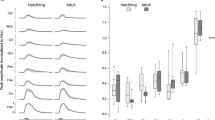Abstract
THE auditory interneurones which ascend the ventral cord of the migratory locust have been traced forward only as far as the neck connectives1,2. Fibres which give a similar response can occasionally be found in the lateral parts of the protocerebrum or in the optic lobes by probing with indium-filled platinum-plated microelectrodes. They have not been found, although sought, in the corpora pedunculata. However, by probing in the optic lobe, higher-order neurones which give a different set of responses to auditory stimuli are commonly encountered. These also respond to vibration or touch stimuli of all kinds, to a wide range of visual stimuli via either compound eye, but only to high-intensity stimulation of the ocelli. The most easily found example is in the outer layers of the medulla in the optic lobe. Typically they consist of units which are presumably large because they give large spikes, with a background spike discharge ranging from 1 impulse per 10 sec to 10 per sec. Sensitivities to all modalities are low, compared with other units which respond typically to only one of the modalities. No evidence of association between inputs has been found, although sought. When the stimulus is repeated regularly at intervals of up to 10 sec, the response almost always declines in number of impulses, occasionally down to no response with irregular return of the response to some of the stimuli. The upper limit of repetition frequency varies greatly between units, or between what appear to be the corresponding units in different animals. Also, the rate of decline of the response varies greatly as between units for a standard frequency of stimulus repetition. Responses to different modalities adapt at different rates. Adaptation to a stimulus of one modality does not usually influence the response to a different modality of stimulus newly introduced, demonstrating an independence of inputs, and separate adaptation to each.
This is a preview of subscription content, access via your institution
Access options
Subscribe to this journal
Receive 51 print issues and online access
$199.00 per year
only $3.90 per issue
Buy this article
- Purchase on Springer Link
- Instant access to full article PDF
Prices may be subject to local taxes which are calculated during checkout
Similar content being viewed by others
References
Horridge, G. A., Proc. Roy. Soc., B, 155, 218 (1961).
Suga, N., and Katsuki, Y., J. Exp. Biol., 38, 759 (1961).
Author information
Authors and Affiliations
Rights and permissions
About this article
Cite this article
HORRIDGE, G. Multimodal Interneurones of Locust Optic Lobe. Nature 204, 499–500 (1964). https://doi.org/10.1038/204499b0
Issue Date:
DOI: https://doi.org/10.1038/204499b0
This article is cited by
-
Central projections of first-order ocellar interneurons in two orthopteroid insects Acheta domesticus and Periplaneta americana
Cell and Tissue Research (1984)
-
The tritocerebral commissure giant (TCG): A bimodal interneurone in the locust,Schistocerca gregaria
Journal of Comparative Physiology ? A (1978)
-
Non-motor, efferent electrical activity in the antenna of the water-striderGerris paludum (Hemiptera, Insecta)
Journal of Comparative Physiology ? A (1975)
-
Movement discrimination by the visual system of flies
Zeitschrift f�r Vergleichende Physiologie (1971)
-
Convergence of antennal and ocellar inputs in the insect brain
Zeitschrift f�r vergleichende Physiologie (1970)
Comments
By submitting a comment you agree to abide by our Terms and Community Guidelines. If you find something abusive or that does not comply with our terms or guidelines please flag it as inappropriate.



